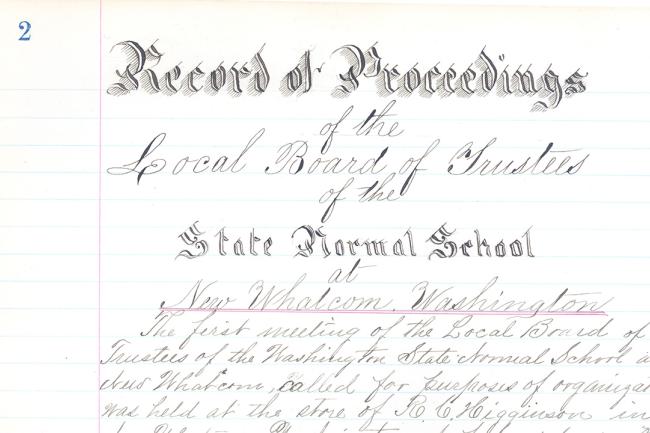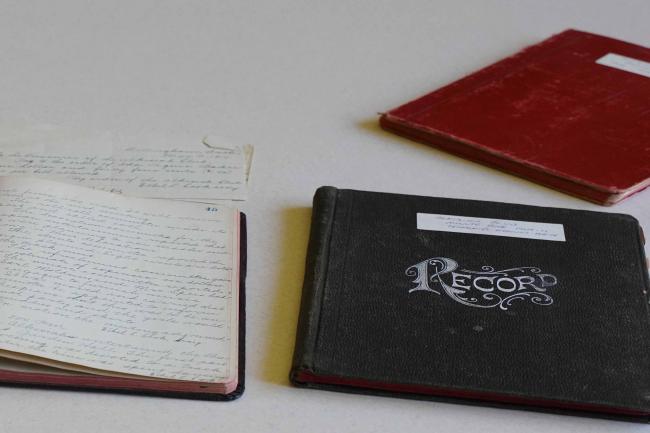Records Retention Schedules
WWU General Records Retention Schedule

The WWU General Schedule applies to common records found in most offices. Staff should also check the office records retention schedules to see if there are additional titles specific only to their office.
Office Records Retention Schedules

Office-level retention schedules apply to records created and maintained by, and usually unique to, individual offices. Not all offices use or need these specific schedules. In any case, staff will always need to consult the WWU General Schedule for instructions regarding common types of records that are not unique to an office.
How to use the Schedules

Learn basic details about how to read, interpret, and use retention schedules.
How to Use University Records Retention Schedules
Approved records retention schedules provide a roadmap for records management, and they apply to all university records, regardless of format or system.
Retention Schedule Development
The University Records Officer develops retention schedules in cooperation with the State Records Committee, Washington State Archives, WWU staff, and, when appropriate, with advice from the WWU Assistant Attorney General. The Washington State Records Committee then approves the retention schedules pursuant to its authority under the provisions of Chapter 40.14 of the Revised Code of Washington. The State Records Committee is composed of representatives of the Offices of State Auditor, Attorney General, Financial Management, and the State Archivist.
Retention Schedule Types
At Western, there are two kinds of approved retention schedules:
- WWU General Records Retention Schedule
- Office Records Retention Schedules
These two types of schedules work in unison:
- All staff should consult the WWU General Records Retention Schedule as it contains instructions for records that exist in many or even all offices.
- Many offices also have office-level retention schedules containing instructions for additional records that are unique to those offices.
The following content is an overview of how to interpret and implement approved retention schedules at WWU.
Reading the Retention Schedule
The Record title will usually appear as a heading or in bold letters at the top of the entry for that record. Sometimes it is referred to as "Records series"--and in our usage with respect to WWU retention schedules, the terms are interchangeable. In our web version of the retention schedules, users can click on the record title to open a unique page for the title--which could be useful for saving or sharing as a link directly to that title.
The record Description will indicate the nature of the records covered by that title, the function or activity they document, and typical records created under that title--or, often just as important, what records are excluded from coverage. The description might also include what office has primary responsibility for the records.
The State Records Committee assigns a unique disposition authority number (DAN) to each record described on the retention schedules it reviews and approves. The DAN obligates WWU to meet the retention requirement for a record and authorizes WWU to carry out the stated disposition once the record has met or exceeded its required retention.
On WWU retention schedules, the DAN is incorporated into the WWU Disposition Authority Reference, which links the DAN to a specific record listed on a retention schedule or file plan. Because the WWU Disposition Authority Reference contains this additional contextual information, we advise users to reference it whenever referring to a specific title on a retention schedule, especially when recording the disposition of records.
The retention and disposition instructions specify how long the records governed by that title must be kept, as well as what must happen to the records once the retention period is complete. These instructions are made up of three parts.
Cut-off: The date or event at which the record becomes inactive and the retention period begins.
Retention period: The length of time the records must be kept after the cut-off has occurred.
Disposition: What must happen to the records once the total retention period (cut-off plus retention period) has been met. Generally, disposition is either "Destroy" or "Transfer to Archives."
This designates whether a record has special status as an identified archival record or essential record. These designations carry additional responsibilities and are therefore clearly identified on state-approved retention schedules.
AT WWU we classify records according to pre-defined functions in order to provide easier access points. In our web version of the WWU General Records Retention Schedule, users can use the Function term to filter the schedule into more meaningful subsets.
Applying the Retention Schedule
As noted previously, there are two kinds of approved retention schedules at WWU: the WWU General Records Retention Schedule and the Office Records Retention Schedules. These two schedules work in unison.
Users should check the Office Records Retention Schedules to see if their office has unique titles assigned to it. Titles on office retention schedules are not transferrable to other offices. If your office needs specific titles on its office-level schedule (or would like to create an office schedule if one does not exist), contact UARM.
Users should also check the WWU General Records Retention Schedule for titles that can be used by anyone on campus.
You can use the titles you identified as a kind of outline for organizing your files, wherever you are managing them. If the records are part of an information system that is managed by IT, you may need to coordinate with IT in order to carry out retention and disposition actions. Contact UARM for assistance or additional guidance.
Once you have identified the appropriate record title that fits your records, determine if the records have met the total retention period requirement. Note that the retention period for a record does not begin until the cut-off.
If the record has exceeded its required retention period AND is not subject to any legal holds that would prevent its disposition according to the schedule, follow the disposition instructions noted on the retention schedule for the applicable record title. Never destroy a record that is subject to a legal hold.
- For records that are eligible for destruction, see our guide to Records Destruction.
- If disposition instructions state that the record is archival and needs to be transferred to the University Archives, contact us or see our Transferring Records page.
Important note for scanned records: If your office has scanned its paper or other non-digital records and would like to keep the digital copies instead of the originals, you must contact UARM before destroying the non-digital records. The State Archivist requires us to complete a self-audit before destroying the original records after digitization, and UARM can assist offices with that process. Records designated as "Archival" on a retention schedule may not be destroyed, even after digitization--they must be preserved both in their original format and in their digital format.
Both archival and non-archival paper records that have not met the total retention period, but have passed the cut-off event, can be sent to the University Records Center. Consult our Transferring Records page for assistance, or contact us. Once the retention period has been met for records stored in the University Records Center, UARM will initiate the appropriate disposition action by notifying the office.
Digital non-archival records that have not met the total retention period must be managed by the office of record. Contact us for advice and consultation about how to manage those records, as the process might vary depending on the system in which the records are managed.
Digital archival records may be transferred to the University Archives once the cut-off event has occurred. For more information about transferring digital records to the University Archives, please contact us.
Records that have not met their specified cut-off point must be managed by the office of record until the cut-off has occurred.